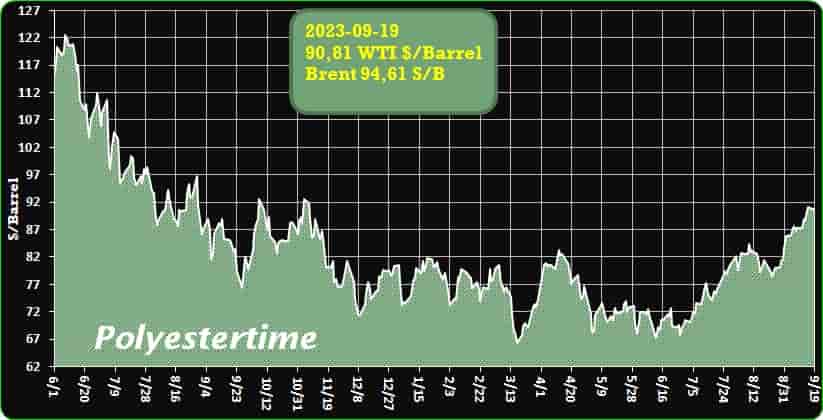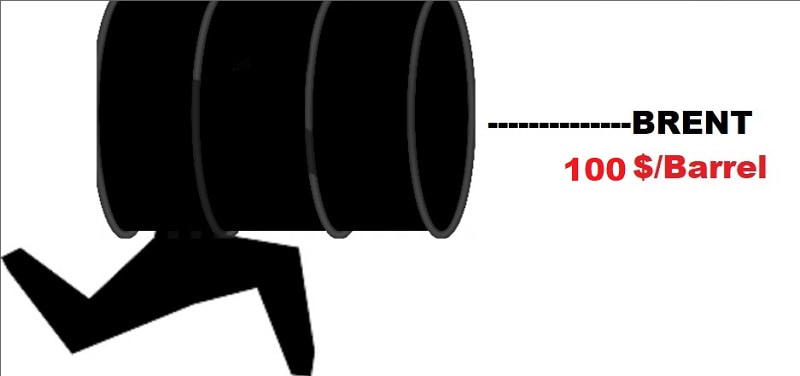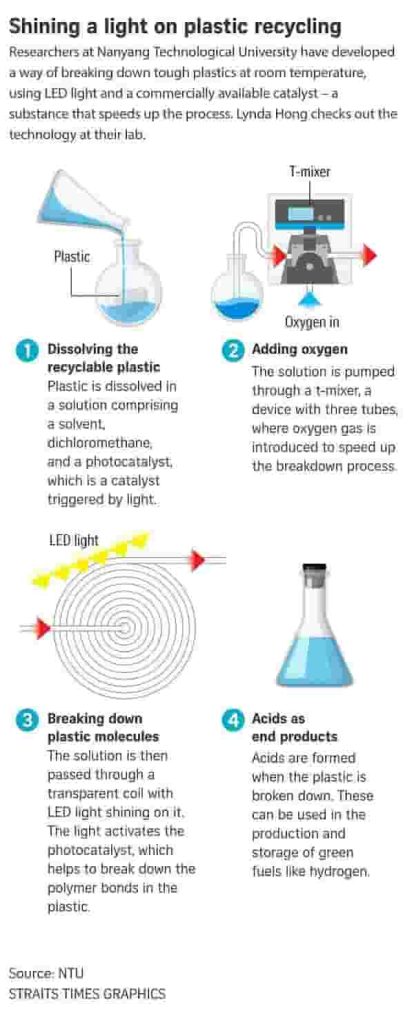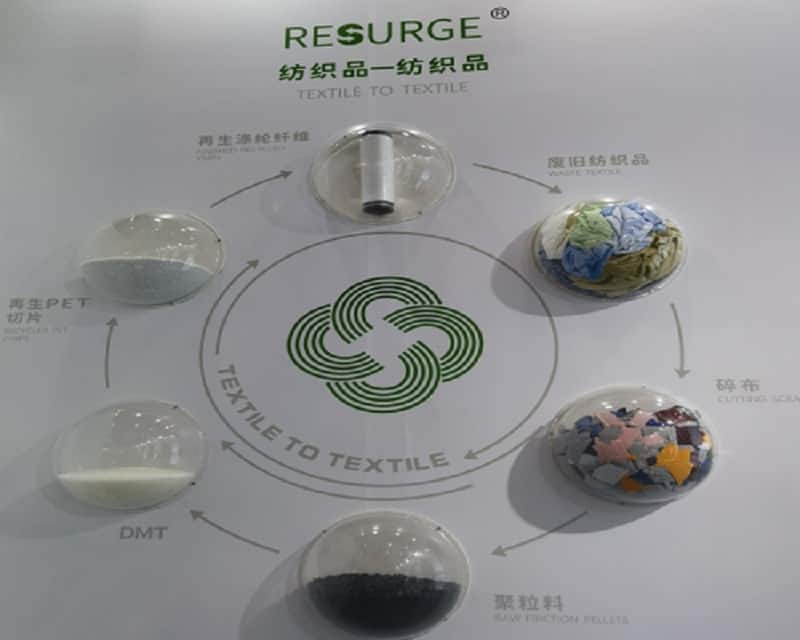Crude Oil Prices – NTU researchers develop new way to recycle plastic that leaves minimal carbon footprint 19-09-2023
Crude Oil Prices
Crude Oil Prices Trend

Crude Oil Prices Trend by Polyestertime

NTU researchers develop new way to recycle plastic that leaves minimal carbon footprint
Research Breakthrough: Scientists from Nanyang Technological University (NTU) have developed an innovative method for recycling plastic with minimal carbon footprint
Process Overview: The process employs light and a readily available photocatalyst to efficiently break down plastic materials, including plastic bags, takeaway boxes, styrofoam, and PVC pipes. The resulting acids, like formic acid, acetic acid, and benzoic acid, can be used to produce green fuels, such as hydrogen.
Upcycling vs. Recycling: The researchers prefer the term “upcycling” for this process, as it differs from traditional mechanical recycling that tends to reduce plastic durability.
Commercial Potential: The technology is currently in the process of being patented, and the research team is seeking industry collaborators for commercialization. It offers potential benefits for the clean energy sector, particularly in the development of liquid organic hydrogen carriers (LOHCs) for safer hydrogen transport.
Challenges: Currently, the derived chemicals from this method may be more expensive compared to those produced from fossil fuels. Crude Oil Prices
However, the technology shows potential for producing higher-value specialty chemicals for fragrances and paints.
Efficiency Enhancement: Ongoing research and development aim to improve the efficiency of this technology so that it can process large quantities of plastic waste within a shorter timeframe.
Carbon Footprint: While the exact carbon footprint reduction has not been quantified, the new method is expected to have significantly lower emissions compared to conventional pyrolysis and mechanical recycling processes. Crude Oil Prices
Carbon Storage in Plastics: Plastic waste is highlighted as a form of carbon storage, as it prevents the release of carbon dioxide into the atmosphere. Biodegradable plastics may not necessarily have a smaller carbon footprint due to their chemical makeup.
Environmental Impact: The accumulation of non-biodegradable plastic waste in landfills and the environment has potentially prevented the release of a substantial amount of carbon dioxide, contributing to efforts to limit global warming.
This innovative plastic recycling process has the potential to reduce carbon emissions, enhance the sustainability of plastic materials, and contribute to cleaner energy production. Crude Oil Prices

‘Waste to resources’: SK gets ball rolling in high-tech plastic recycling
The process of recycling plastics is most widely known to be about breaking used plastics into little pieces, washing, sorting and drying them before turning what’s left of them into new plastics.
Chemical recycling, the more sophisticated method, involves extracting raw materials from used plastics or significantly changing the chemical structure of the waste; hence, there is no need to sort by color or condition of contamination.
Korea’s SK Group, the second-largest conglomerate in the country by assets, which has major oil refinery and petrochemical units under its wing, is at the vanguard of chemical recycling as it steps up the drive for a green energy transition toward decarbonization.
In its main refinery and chemical plant in Ulsan, an industrial city on the southeast coast, SK is building what will be the world’s first plastic recycling cluster with core chemical recycling facilities. Crude Oil Prices
The Advanced Recycling Cluster (ARC) will be built on 215,000 square meters of land ― a size equivalent to 22 football stadiums ― inside the 8.3-million-square-meter Ulsan CLX.
The 1.8 trillion-won ($1.35 billion) project is scheduled to break ground next month, aiming to begin operations in 2025.
“Some 320,000 tons of plastic waste ― which is 213 million 500-milliliter PET bottles of water ― will be recycled every year once the ARC is operational,” said Kim Ki-hyeon, an official at SK Geocentric, the chemical unit in charge of the ARC, during a press tour in Ulsan on Wednesday.
The recycling cluster will house three major chemical recycling facilities: high-purity polypropylene (PP) extraction, depolymerization of PET plastics or polyester, and pyrolysis.
Depolymerization chemically turns plastic and fiber waste into the original form of monomers and enables recycling without quality degradation. SK is working with Canada’s Loop Industries on the depolymerization technology.
For PP extraction, SK is collaborating with U.S. Purecycle Technologies, which specializes in extracting ultra-pure PP resin. Crude Oil Prices
SK has a license contract with British recycling company Plastic Energy for pyrolysis, a technology that converts plastic waste into crude oil through high-temperature heating with limited oxygen. Plastic items, such as baby bottles and interior materials for vehicles, are made using crude oil.
SK Innovation, SK’s energy unit, plans to use the pyrolysis oil as feedstock for its naphtha cracking by refining it using the post-pyrolysis processing it has developed.

Covestro, Selena launch bio-attributed PU foams for thermal insulation applications
Covestro and Selena Group have joined forces to introduce a line of eco-friendly polyurethane (PU) foams designed for improved thermal insulation in construction applications, as reported by Sustainableplastics.
Selena has integrated Covestro’s bio-attributed methylene diphenyl diisocyanate (MDI) into an upgraded version of its Ultra Fast 70 one-component foam, commonly used for window and door installations. This material bears the ISSC Plus certification, indicating the incorporation of plant-based feedstocks through the mass balance method, resulting in an impressive 60% reduction in carbon emissions compared to foams derived from fossil fuels. Crude Oil Prices
The Ultra Fast 70 foam formulation drastically reduces installation time for doors and windows, enabling a greater number of projects to be completed within the same timeframe, according to Selena. It reportedly achieves full curing in just 90 minutes, a significant improvement over competing products that typically require around 24 hours for curing. Additionally, this foam yields 70 liters per container, reducing the overall quantity needed for window or door installations.
This innovative product boasts similar performance characteristics to its fossil fuel-based counterparts, allowing customers to seamlessly integrate it into their existing processes without sacrificing quality. In addition to the bio-attributed PU foam, Selena incorporates bio-based polyols and recycled PET materials into its range of foam products.
Covestro’s recent partnership announcement coincides with reports of ongoing discussions with Abu Dhabi National Oil Co. (ADNOC) regarding a potential acquisition of the German company Crude Oil Prices

Green hydrogen: the future of sustainable energy at your fingertips
Green hydrogen is a clean and abundant energy source that is rapidly transforming the way we meet our energy needs. With falling costs and optimistic forecasts, green hydrogen could soon become an everyday reality, helping to reduce carbon emissions and ensure a cleaner future for our planet. Crude Oil Prices
Key takeaways:
- Green hydrogen produced from renewable sources is expected to become competitive with gray hydrogen derived from methane or industrial waste in existing plants by 2030 in at least five key markets.
- New green hydrogen projects will become cheaper than keeping existing gray ones running in Brazil, China, Sweden, Spain, and India by 2030.
- Brazil will get the lowest cost for green hydrogen by 2023, estimated at $1.47 per kilogram.
- By 2050, the cost of newly built green hydrogen will be lower than the marginal cost of gray hydrogen from existing plants in all markets modeled.
- Some significant challenges remain for the domestic adoption of green hydrogen, including the high energy requirements for production and the need for a specialized network of electrolyzers and distributors.
- However, there is an interesting prospect for the use of green hydrogen in domestic off-grid. Two German companies have developed systems to produce and store hydrogen at home during the summer, capable of covering winter energy consumption, including heating. Crude Oil Prices
Conclusion:
Green hydrogen is a promising solution for the energy transition. While challenges remain in domestic adoption, the use of green hydrogen is gaining momentum, and it is poised to become a driving force in the energy industry by 2030.
In addition to the key takeaways above, I would like to add that green hydrogen has the potential to revolutionize many sectors of the economy, including transportation, industry, and power generation. It can be used to produce clean fuels, chemicals, and electricity. It can also be used to store energy from renewable sources, such as solar and wind power.
Green hydrogen is a versatile and sustainable energy source that has the potential to help us achieve our climate goals. With continued investment and research, green hydrogen could soon become a key part of our global energy mix. Crude Oil Prices

Recycled products and development trend in Yarn Expo Autumn 2023
Yarn Expo Autumn 2023 is held in Shanghai during Aug 28 and Aug 30. The Yarn Expo has decent popularity, although it is slightly less popular than the Yarn Export held in spring in the first half of the year. The highest level of popularity is observed in 8.2 Hall.
- Market sentiment
Ningbo Dafa and Guangdong Tok Zin raised the HC re-PSF offers by 100yuan/mt on Monday, and then part of plants in Jiangsu raised the HC re-PSF offers by 100yuan/mt and solid re-PSF offers by 50yuan/mt on Tuesday. The price increase this year is mainly pushed by higher feedstock market and sales are divergent. Sales are ordinary in Zhejiang and Jiangsu, and producers show concerns over the feedstock supply and demand in buoyant season later. Crude Oil Prices
1) Market participants worry about the market in buoyant season. Recently, HC re-PSF sales are ordinary, and price increase is sporadic. Producers mainly stand on the sidelines. Part of HC virgin PSF plants lacks advantages, and is hard to compete. A few new production lines are delayed.
2) Boheng specializes in differentiated recycled PSF. Currently, there are 114 colors in their color card, and many of these colors are quite dreamy, especially appealing to niche differentiated customers. The necessity of OBP (Ocean bound Plastic) becomes more prominent with Japan’s release of nuclear wastewater, as the urgent need to save plastic in nearby seas becomes apparent. It is reported that there are only three domestic manufacturers of recycled fibers with OBP certification: Boheng, Zhongyuan, and Cyclone.
Ocean Bound Plastics, abbreviated as OBP, refers to improperly managed plastic waste that is abandoned in the environment, where it can be transported to the ocean through rain, wind, tides, rivers, and floods. Plastic waste in landfills or managed waste facilities is not considered OBP, but plastic waste in uncontrolled informal landfills within 50 kilometers of the coastline is considered OBP. The purpose of OBP is to protect the ocean from plastic pollution originating from land-based activities, rather than recovering plastic from the ocean through fishing or collection efforts. Crude Oil Prices
3) Zhejiang Jiaren continues to expand capacity on chemical recycling, and R-DMT is launched this year.
4) The production process under chemical recycling of Cyclone is below. According to Cyclone, the costs of chemical recycling are 3,000-5,000yuan/mt higher than that of physical recycling.

TotalEnergies launches green hydrogen tender call
TotalEnergies has initiated a tender call for the annual production of 500,000 tons of “green” hydrogen, marking a significant step in the company’s efforts to reduce carbon emissions from its European refineries. This move, aimed at decarbonizing its industrial activities, involves replacing “grey” hydrogen with green hydrogen, which is produced using renewable energy sources. TotalEnergies expects this transition to result in a reduction of approximately five million metric tons of CO2 emissions per year across its European refineries, including its three oil refineries and two biorefineries in France.
In addition to the large-scale tender call, TotalEnergies will complement its efforts with smaller local projects. Furthermore, the company has entered into an agreement with Air Liquide to supply the Gonfreville refining platform with up to 15,000 tons of green and low-carbon hydrogen annually, with the potential to reduce carbon emissions by 150,000 metric tons each year. Crude Oil Prices
Jean-Marc Durand, the director of petrochemical refining in Europe at TotalEnergies, emphasized the need for a significant quantity of electrolyzers and highlighted that the purpose of the tender call is to stimulate growth in this sector. Durand stated, “We talk a lot about green hydrogen, but at some point, players like us need to commit to getting these sectors off the ground via massive calls for tender. There needs to be an effect of scale. That’s what this work is all about.”
TotalEnergies is also counting on various European regulations and incentives to achieve competitive pricing for green hydrogen. Typically, green hydrogen costs two to three times more than grey hydrogen, as explained by Sebastien Bruna, the director of hydrogen in the refining branch of TotalEnergies.
The European Union recently granted final approval for legally binding targets to accelerate the expansion of renewable energy sources during this decade. Notably, this decision allows France to consider nuclear power in the production of hydrogen as part of its renewable energy strategy. Crude Oil Prices

How Spinnova and Renewcell want to scale circularity in fashion
Spinnova and Renewcell, two innovative companies, have joined forces to introduce a groundbreaking technology concept aimed at expanding the production of a novel textile fiber derived from textile waste.
This pioneering fiber production concept harnesses patented technologies from both organizations with the shared goal of amplifying circularity within the fashion and textile sectors. Crude Oil Prices
Renewcell is at the forefront of establishing a circular economy in the fashion industry by recycling cellulosic-rich textile waste, including cotton and viscose. They employ a patented process to transform textile waste into a pulp substance known as “Circulose.” This biodegradable raw material is crafted entirely from recycled textiles and can be utilized to craft new fibers. Up until now, Circulose has primarily been used in the creation of man-made cellulosic fibers like viscose. However, with the transformative technology offered by Spinnova, these partners can convert Circulose into an innovative, biobased textile fiber without the need for any harmful chemicals during the spinning process.
Spinnova has already conducted successful trials in spinning Circulose pulp into a novel textile fiber. The initial batches of Spinnova fiber, composed entirely of Circulose, have been generated for yarn and fabric development. The initial prototypes incorporate a blend of cotton and Spinnova fiber based on Circulose. Crude Oil Prices
Ben Selby, Deputy CEO of Spinnova, expressed, “The fashion and textile industry is in need of fresh solutions and enhanced collaboration across its supply chain, making this partnership incredibly exciting for us. Our objective is to accelerate the fashion industry’s transition toward a circular economy and explore opportunities for expanding textile-to-textile fiber production.”
Patrik Lundström, CEO of Renewcell, added, “The textile industry is currently undergoing a significant transformation, transitioning from a linear business model to a circular economy. Exploring Spinnova’s technology has been a thrilling journey, and we are eagerly anticipating the launch of the first collection crafted from Circulose using Spinnova’s distinctive fiber spinning technology.” Crude Oil Prices
At present, the companies are in the process of evaluating options for initiating the scaling of textile-to-textile fiber production with potential partners. They anticipate commencing the development of the first consumer collection made from Circulose-based Spinnova fiber. The initial consumer products are projected to enter the market by the conclusion of 2024.

Crude Oil Prices
